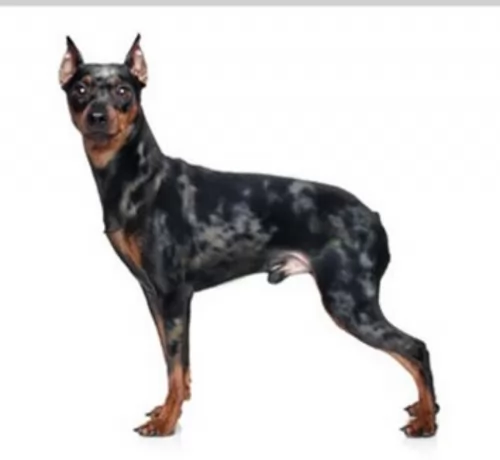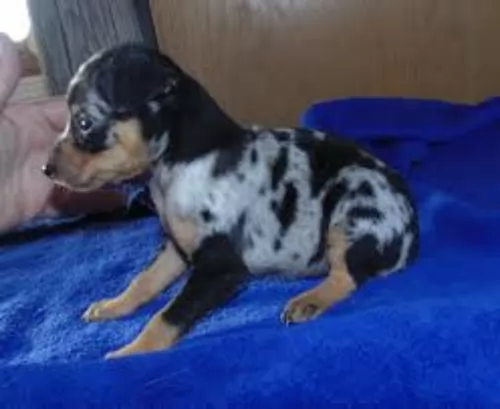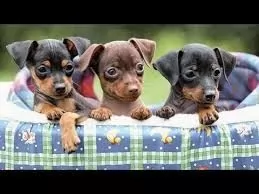 Petzlover
Petzlover Harlequin Pinscher is originated from Germany but Mudi is originated from Hungary. Harlequin Pinscher may grow 14 cm / 5 inches shorter than Mudi. Harlequin Pinscher may weigh 9 kg / 19 pounds lesser than Mudi. Both Harlequin Pinscher and Mudi has almost same life span. Harlequin Pinscher may have less litter size than Mudi. Harlequin Pinscher requires Low Maintenance. But Mudi requires Moderate Maintenance
Harlequin Pinscher is originated from Germany but Mudi is originated from Hungary. Harlequin Pinscher may grow 14 cm / 5 inches shorter than Mudi. Harlequin Pinscher may weigh 9 kg / 19 pounds lesser than Mudi. Both Harlequin Pinscher and Mudi has almost same life span. Harlequin Pinscher may have less litter size than Mudi. Harlequin Pinscher requires Low Maintenance. But Mudi requires Moderate Maintenance
 This toy-sized dog is a type of Miniature Pinscher originating in Germany. The dog was developed by crossing traditional Miniature Pinschers with other toy-sized short-haired terriers. He falls into the Terrier category.
This toy-sized dog is a type of Miniature Pinscher originating in Germany. The dog was developed by crossing traditional Miniature Pinschers with other toy-sized short-haired terriers. He falls into the Terrier category.
The dog was used to kill rats, but has always been a devoted pet at the same time. They nearly became extinct after World War II, but the breed was once again restored. Today it is an established breed, but it isn’t recognized by any of the major kennel clubs.
In fact, The Harlequin Pinscher Association is the only breed club that recognizes the Harlequin Pinscher. It can be registered with the Harlequins Pinschers Association or with the American Canine Association.
 Sometime between the 4th and 6th centuries, the Great Migration – a variety of dogs came to live in the Carpathian Mountains on the Great Hungarian Plain. This migration period brought sheepdogs and herders brought by shepherds. These dogs were of two sizes both small and large. The smaller ones were bred together – Pumi, Puli, and Mudi. Because of this, these breeds share the same history, with the Mundi being the oldest of them all.
Sometime between the 4th and 6th centuries, the Great Migration – a variety of dogs came to live in the Carpathian Mountains on the Great Hungarian Plain. This migration period brought sheepdogs and herders brought by shepherds. These dogs were of two sizes both small and large. The smaller ones were bred together – Pumi, Puli, and Mudi. Because of this, these breeds share the same history, with the Mundi being the oldest of them all.
The Mundi was finally separated from the other breeds about 1930 when Dr. Deszo Fenyesi began to breed them. It was in 1966 when the F.C.I. finally approved the standard for the breed. Still then as today, there were not many breeders developing the Mudi. They are working dogs – farm dogs – herders, guard dogs and ratters. He is also known as a tracker, with the majority of the breed living in Hungary.
As the Mudi was bred separately from the Pumi and the Puli, differences between the breeds became clear. Many Mudi are born with a stump or no tail at all. The Mudi is not a great dog for the first timer. He is stubborn, assertive and needs a lot of socialization and exercise. In 2004 breeders in the United States created the Mudi Club of America to preserve the breed and foster responsible ownership. This is a clever, active and keen breed, very loyal to his family but wary of strangers. The United Kennel Club recognized the breed in 2006.
In Hungary, these are still a breed of herding dogs capable of running 500 sheep at a time. They are versatile, courageous, intelligent and agile. They are great in obedience trials, agility, and flyball. In Finland and the United States, they also work as search and rescue dogs.
 This is a small compact dog standing at 25 – 33cm in height and weighing about 3kg to 4 or 5kg. He has dark eyes and ears which are set high and which are erect with just the top of them folding forwards.
This is a small compact dog standing at 25 – 33cm in height and weighing about 3kg to 4 or 5kg. He has dark eyes and ears which are set high and which are erect with just the top of them folding forwards.
The legs are straight and thin with small cat-like shaped paws. The tail is traditionally cropped, but these days the tail is left longer. He has a short coat which is available in a range of colors – black, brown, red, fawn patterns of merle, brindle or piebald. The Harlequin Pinscher is like a Bambi or a small deer, especially when they're a bit long in the leg.
Alert and inquisitive, the Harlequin Pinscher is a feisty, devoted little dog, brave and loyal and he has a lot of energy. He is intelligent too and with training and socialization, he becomes such a pleasure to have around, obedient and responding well to instructions.
He is known to be good with other pets as well as with children, so long as the children have been taught to respect animals. As always, a dog pretty much turns out the way the owners are, and with training and firmness while being patient and fair, you don’t have to worry about your Harlequin turning into a ‘small dog syndrome’ animal – whining, snappy and disagreeable. He is actually described as a big dog in a tiny dog's body.
The Harlequin Pinscher is a social dog and wants to be with you wherever you go.
 This is a medium size dog with an almost square profile. They have erect ears on wedge-shaped heads. He is not a strong boned but medium boned. That square profile is based in large part on their very square stance. Their muzzle is about half the length of their head and they have what is considered a “dare devil” expression in their dark, almond-shaped eyes. The color of the eyes is important and must match with the color of the dog or the standard is not met.
This is a medium size dog with an almost square profile. They have erect ears on wedge-shaped heads. He is not a strong boned but medium boned. That square profile is based in large part on their very square stance. Their muzzle is about half the length of their head and they have what is considered a “dare devil” expression in their dark, almond-shaped eyes. The color of the eyes is important and must match with the color of the dog or the standard is not met.
Merle fur – brown, brown speckled, blue eyes.
Brown or gray-brown fur – Brown eyes
Gray fur – gray eyes
What is not acceptable is having yellow eyes and black fur; pink eyes and white fur. The lips, eye rims, and nose must all have the same pigmentation. This should be black in all but the brown and brown-grey dogs. These dogs have brown noses, eye rims, and lips. The tail can be almost anything from full to bob. All are considered to be natural lengths for a Mudi.
Their coat is self-cleaning and won’t mat. It is on the long side. In fact, a short, flat, smooth coat is a disqualification from the standard. The color of the coat ranges from white to brown to gray, gray-brown, merle, golden, cream and white. Very little markings of any kind are usual.
 The Harlequin Pinscher may have once been good at catching rats but these days they are much more sought after for their ability to be a splendid companion and pet.
The Harlequin Pinscher may have once been good at catching rats but these days they are much more sought after for their ability to be a splendid companion and pet.
He is such an entertaining, social little dog, wanting to spend as much time with you as possible. He is fearless, energetic, playful, confident, loving and intelligent and those who have owned them say they are courageous way beyond their size.
He is strong willed, stubborn and confident and this larger-than-life dog is just waiting to show you what a wonderful friend he can be to you too.
 Yes, they are great with children and love being a part of a large family or “pack”.
Yes, they are great with children and love being a part of a large family or “pack”.
They are extremely versatile and great at herding and guarding.
They are adaptable if you are. They don’t need to live in the country, but they need space to run and play.
They are highly intelligent but a little stubborn. Their ability to learn is high but you have to be the boss.
 Harlequin Pinschers, just like other dog breeds, have health issues that they are prone to such as epilepsy, dental issues, obesity and Patellar Luxation.
Harlequin Pinschers, just like other dog breeds, have health issues that they are prone to such as epilepsy, dental issues, obesity and Patellar Luxation.
Some seizures in dogs are genetic or related to illness. A dog could have ingested something poisonous while a head injury can also cause seizures in dogs. If your pet has a seizure you may notice foaming at the mouth, drooling or twitching of the legs.
After a seizure you could see your dog walking in circles and bumping into things. It is important to get your pet to the vet as soon as possible.
 The Mudi does face several of the problems that medium to large dogs often face and some eye issues as well.
The Mudi does face several of the problems that medium to large dogs often face and some eye issues as well.
 The short, smooth coat of the Harlequin Pinscher is easy to maintain, shedding little. With such a small, nimble dog, you can even take a damp cloth and wipe him down. You can brush him down once or twice a week to keep his coat healthy and shiny.
The short, smooth coat of the Harlequin Pinscher is easy to maintain, shedding little. With such a small, nimble dog, you can even take a damp cloth and wipe him down. You can brush him down once or twice a week to keep his coat healthy and shiny.
Dogs can develop dental problems such as tartar and plaque build-up. and this can lead to canine dental problems which can turn life-threatening as bad teeth affect the heart, kidneys and the liver.
You need to brush your pet's teeth 2 or 3 times a week making use of canine toothbrush and toothpaste. Never use regular human toothpaste for your dog as it can be poison to him. It is why dry kibble is better than soft food as the soft food sticks to the dogs teeth.
Your Harlequin Pinscher is also a member of the toy breed group and he has high energy levels. Always choose a high quality kibble for a small dog breed and also which is in keeping with his age and activity levels. He will do well on a high quality dry commercial food, some raw meat or home-cooked food such as chicken, brown rice, pasta and vegetables. If your dog is an energetic dog, he will benefit from a diet rich in protein.
It will be tempting to feed your little pet tasty treats such as chocolate, nuts, coffee and milk but be careful as these can cause severe digestive problems with your dog.
 The Mudi needs a high quality, medium breed puppy dry food and should be fed 3 or 4 times a day for a total of 1 and ½ to 2 cups.
The Mudi needs a high quality, medium breed puppy dry food and should be fed 3 or 4 times a day for a total of 1 and ½ to 2 cups.
The adult should be fed at least twice a day with an adult medium breed high-quality dry dog food. Don’t overfeed as the breed can have a tendency toward obesity.
They have great stamina and agility.
This is a working dog and like most herding dogs, they need a job and a lot of activity. Long walks every day and either a large yard or visits to a dog park. Involve them in herding activities or Barn Hunt if you can. Playing is their way of working when they are not herding real animals. So, if you want this breed, be sure you have time for playing with them. They are great at agility, flyball, obedience, frisbee trials, tracking and of course herding